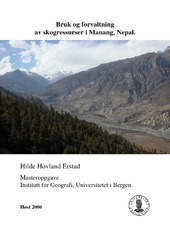| dc.description.abstract | The Masters thesis ‘Use and management of forest resources in Manang, Nepal’ is a study of the necessity of forest resources in a village in Himalaya. It explores how the resources are understood as common pool resources, and how the local management institution deals with the governing of resource use. The valley of Manang is located in the rain shadow of the Annapurna mountains, at 3500 m.a.s.l. Due to climatic and geological conditions, the agricultural conditions are harsh, and crop production is heavily dependent on local fertilization. The farming system of Manang is intertwined with the use of resources from the out-of-field areas. Husbandry is a necessity for agriculture as producers of fertilizer, and thereby creating a need for grazing fields. Further, pine needles constitute a large part of the in-field fertilization. In addition to pine needles and grazing, the forest is producing firewood necessary for cooking, in addition to timber for building. A typical household also leans on the forest as a producer of mushrooms, berries and herbs, and medicinal plants have been collected as a trade component for centuries. The local management of the use of forest resources has old traditions in Manang. A former khampa system is carried on, with the name of panchayat or VDC. The VDC-members in Manang are appointed by the elders, and agreed upon by a village meeting. Every household has a duty to send a male member to the village meeting, which is also the place where rules and arrangements of the management practise is altered. The inhabitants of Manang acknowledge a common pool regime of the resources, and the need to limit each appropriator’s use of forest products. The study uses theories of commons to explore conditions for the management institution. Central themes in the analysis are the importance of the resources for the users, heterogeneity in the user group, and not least influence of external factors as migration and official initiatives. An important aspect has been the need to understand the institution as something more than a purposive institution for forest management, and to appreciate how this institution works in a complex local community. | en_US |
